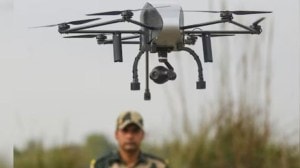Mumbai’s poor AQI and erratic temperatures fuel respiratory ailments
The city’s fluctuating temperatures—marked by warm days and cooler nights—are exacerbating the crisis.
 According to the Central Pollution Control Board, several Mumbai areas recorded poor Air Quality Index (AQI) levels on Thursday. (Express Photo by Ganesh Shirsekar)
According to the Central Pollution Control Board, several Mumbai areas recorded poor Air Quality Index (AQI) levels on Thursday. (Express Photo by Ganesh Shirsekar)The worsening air quality in Mumbai is causing an increase in respiratory illnesses, with hospitals in the city recording a rise in patients complaining of respiratory infections, aggravated asthma, and pollution-related illnesses.
“We have seen a significant rise in OPD visits and hospital admissions for asthma-related issues in recent weeks, largely due to the poor air quality in Mumbai. Patients with asthma are experiencing more frequent and severe flare-ups, often requiring hospitalization,” said Dr. Sarthak Rastogi, Consultant Pulmonology at S L Raheja Hospital, Mahim.
The city’s fluctuating temperatures—marked by warm days and cooler nights—are exacerbating the crisis. Mumbai’s daytime highs have reached the mid-30s (°C), while nighttime temperatures drop to the low 20s (°C). This significant variation is triggering thermal inversion, a phenomenon where cooler air traps pollutants close to the ground, intensifying smog formation.
Dr. Lancelot Pinto, consultant pulmonologist at PD Hinduja Hospital, explained, “The drop in night temperatures creates a blanket of cold air that traps pollutants like particulate matter and carbon monoxide in the lower atmosphere. This smog layer worsens respiratory conditions such as asthma, bronchitis, and other lung disorders, especially for vulnerable populations.”
\According to the Central Pollution Control Board, several Mumbai areas recorded poor Air Quality Index (AQI) levels on Thursday. Borivali East topped the list with an AQI of 275, followed by Malad West at 260 and Navy Nagar-Colaba at 239. Other severely affected areas included Kandivali West (AQI 219), Deonar (214), and Mazgaon (214), reflecting the city’s ongoing struggle with air pollution.
“The rapid rise in AQI levels, coupled with fluctuating temperatures, is leading to health issues like persistent coughing, sneezing, and difficulty breathing, particularly among children, the elderly, and those with pre-existing conditions,” said Dr. Samir Garde, Director of Pulmonology and Lung Transplant at Gleneagles Global Hospital, Parel.
Children and the elderly remain the most vulnerable to these compounding effects. Paediatricians, including Dr. Amit P. Ghawade of Motherhood Hospitals in Kharghar, report a surge in cases among children aged 8-14 presenting with allergic coughs, colds, and throat irritation. “Poor air quality and fluctuating temperatures exacerbate conditions like asthma and bronchitis in children, often leading to breathlessness and hospitalisation. Parents must remain vigilant and seek timely medical care,” Dr. Ghawade advised.
Elderly patients, especially those with weakened immune systems or cardiovascular conditions, are equally at risk.
Prolonged exposure to high AQI levels and temperature fluctuations presents significant long-term risks, including diminished lung function, chronic obstructive pulmonary disease (COPD), and cardiovascular complications. “Chronic exposure to pollution, coupled with these erratic temperature swings, increases the risk of developing severe respiratory and cardiovascular conditions,” warned Dr. Rastogi.
Healthcare professionals are urging residents to adopt preventive measures. Dr. Garde recommended staying indoors during peak pollution hours, using air purifiers at home, and wearing masks outdoors. “Checking AQI levels before stepping out and avoiding heavily trafficked areas can significantly reduce exposure,” he emphasised.
For children, Dr. Ghawade suggested limiting outdoor activities on high-pollution days and ensuring proper hydration and nutrition to bolster immunity. “Air purifiers at home and avoiding outdoor play during poor AQI periods can help protect children’s health,” he added.
Mumbai’s worsening air quality and temperature fluctuations are not a new phenomena. The city has long struggled with pollution caused by vehicular emissions, construction dust, and industrial pollutants. Despite ongoing awareness campaigns and policy efforts, significant improvements remain elusive.
Dr. Garde called for collective action, saying, “Policymakers, healthcare professionals, and citizens must work together to combat air pollution. Stricter regulations on emissions, cleaner transportation options, and increasing green cover are essential to tackle this crisis.”












